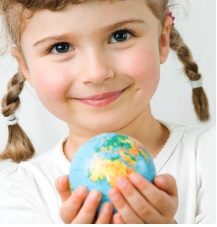For the young child social studies is learning about the importance of families, communities, and cultures. From the first day of school in The Creative Way program the child begins to learn about the culture of his/her school. Teachers lay the foundation of self-respect, respect for one another, independence, and responsibility. Safety, conflict resolution, cooperation, and problem solving teaches children that teamwork and communication makes the school environment conducive for learning. While in school, the teacher helps the children to become aware of what makes themselves and their families unique. The children explore their immediate community by studying the jobs of community helpers such as police officers, firefighters, doctors, nurses and teachers. Through education, teachers and parents extend and expand young children’s knowledge and awareness of the world community. By understanding other cultures, children will be able to communicate with one another more effectively. Teaching children about the global community teaches them how we are all interconnected. Children learn that such concepts as cooperation, conflict resolution, compassion, and respect for other cultures, are important to make the world a harmonious place to live.
In Mimi’s Place classroom, children are also taught that the environment is an essential part of all people’s survival and that protecting it is everyone’s responsibility.
Objectives:
- Family – understands who makes up a family, can name members of own family, can draw a picture of own family.
- Maps – can understand a simple map of the classroom, can follow a simple map of a park or zoo to locate points of interest.
- Cultural awareness – can talk about family rituals or customs, understands about other cultures and can name some holidays or celebrations of their culture and another culture.
- Community – understands what makes up a community, can name three or four buildings in a community (fire station, gas station, bank, hospital, church), can name two or three community workers and describe what they do (firefighter, doctor, teachers).
- Transportation – understands that there are different types of transportation (trucks, cars, airplanes, boats, helicopters, fire trucks) and can describe what each is used for.
- Recycling – understands about trash or things that are discarded and can describe the process of recycling and explain why recycling is good.
TIPS FOR TEACHING SOCIAL STUDIES
The National Council for Social Studies (NCSS; 1994) recommends that Social Studies content be focused around ten broad themes: culture; time continuity and change; people, places, and environments; individual development and identity; individuals, groups and institutions; power, authority, and governance; production, distribution, and consumption; science, technology, and society; global connections; and civic ideas and practices. Each theme should guide teachers based on the interest of the children in their classroom. Theme evolution and development is dependent upon children’s past experiences, developmental stages, and skills.
WEBSITES WHERE MORE ACTIVITIES CAN BE FOUND


Recent Comments